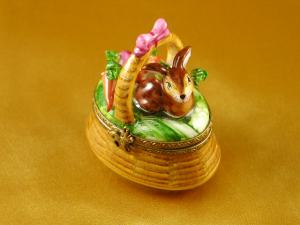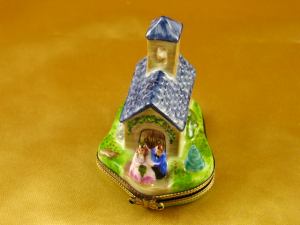Interesting Facts about Porcelain Hinged Boxes
Ethereal, enigmatic, and enchanting-Limoges boxes present flawless works of art, which can enhance the décor and value of even the lonely display shelf at the corner of your room. Coming in delicate hinged trinket boxes and bearing striking scenery and figurines meticulously painted by dexterous hands, these pieces have become much sought-after rare treasures by vintage or antique collectors in recent times.
However, the origin of these wonderful creations goes back to several centuries in France and bears a legendary history to talk about. Here are some interesting facts about Limoges porcelain.
Chinese Porcelain and French Porcelain
Going back in time porcelain was a material synonymous with China and oblivious to the French and rest of Europe. The Chinese porcelain was inimitable at that time and in an act of imitating it, a sort of soft porcelain was produced in certain regions of the continent. This was however, no way comparable to the high quality of porcelain imported from the Chinese soils.
The advent of the special white clay Kaolin was witnessed in the 18th century when the mineral was unfathomed in the city of Limoges near St.Yrieix in France. This material was at par with the ones found in the Kao Ling region of China and had immense potential to create magnificent porcelain artwork. However, it was the creative genius of one German alchemist, who ultimately led to the creation of the fine Limoges porcelain boxes famous worldwide. This was done by carving the white mold base or whiteware through perfect blend of certain materials along with Kaolin.
Limoges Porcelain Manufacturing - Then and Now
Limoges, the city already known for its immaculate art of pottery, became the hub of Limoges porcelain manufacturing under the patronage Mr. Turgot, businessman of the then King Louis XVI. Sevres became the Royal factory producing Limoges porcelain and Limoges produced the first line of porcelain dinnerware under the commission of the Royal Court of France. The Limoges porcelain items of those times bore the words French Fleur de Lys, a symbol marking its authenticity along with royal crests, which have today become marks of appraisal for traditional Limoges items.
With the coming of the 19th century, Limoges saw blossoming of a plethora of factories producing their trademark designs of Limoges porcelain boxes and bringing the beautiful artwork to the forefront of International market. Today, apart from the traditional factories, a number of other companies have seen a booming growth as premier manufacturers and decorators of Limoges porcelain.
One of the top brands is the Rochard line of boxes known the world over for its delightful artistry and custom design. The manufacturing of these exquisite pieces is an assiduous and painstaking process engaging multiple firings done at 1400C, which is responsible for the glistening white finish of the box. The mixture of the porcelain comprises the purest quality of Kaolin clay possessing oxides of aluminum, iron, silicon and others and quartz, pulverized and feldspar.
Understanding Authentic Limoges Boxes
One of the easiest ways of testing the authenticity of Limoges boxes is to understand whether they are porcelain hinged boxes. Hinges in a Limoges box today come in copper or copper alloy materials and are specially mounted by hand, making it fit the box perfectly without being loose. They also come with decorative clasps. Other ways of gauging the genuineness is looking for the Limoges France stamp, surface decoration, artist’s name, mold number and importer’s marks or initials.


No comments:
Post a Comment